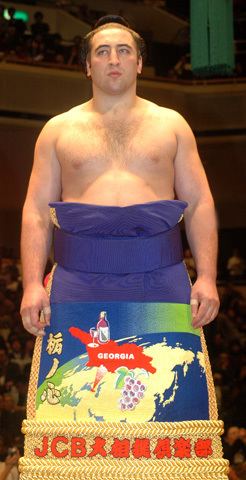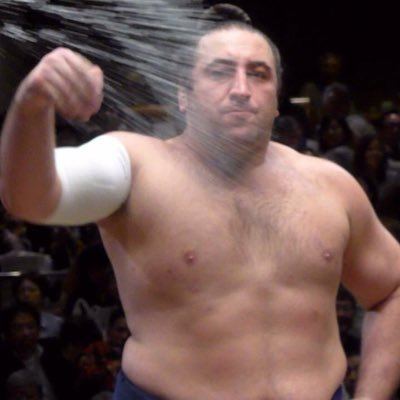Current rank see below Gold Stars 1 (Harumafuji) Height 1.92 m Debut March, 2006 Name Tochinoshin Tsuyoshi Weight 162 kg | Role Sumo Wrestler Martial art Sumo | |
 | ||
Championships 3 (Juryo)2 (Makushita) Similar People Tochiozan Yuichiro, Myogiryu Yasunari, Yoshikaze Masatsugu, Aoiyama Kosuke, Kotoshogiku Kazuhiro Profiles | ||
Highest rank Komusubi (July, 2010) Special Prizes Fighting Spirit (5) Makuuchi rank Komusubi (since 2012) | ||
Tochinoshin Tsuyoshi: new Ozeki from Georgia of Kasugano stable
Tochinoshin Tsuyoshi (born 13 October 1987 as Levan Gorgadze, Georgian: ლევან გორგაძე) is a professional sumo wrestler from Mtskheta, Georgia. He is a member of the Kasugano stable and made his professional debut in March 2006. He reached the top makuuchi division just two years later in May 2008. His highest rank has been sekiwake. After a long hiatus due to injury, he began his comeback from the rank of makushita 55 in March 2014, logging four championships in a row in lower divisions on his way back to the top division in November 2014. He has five special prizes for Fighting Spirit and one for Technique, and two kinboshi or gold stars for defeating yokozuna.
Contents
- Tochinoshin Tsuyoshi new Ozeki from Georgia of Kasugano stable
- Early life and sumo background
- Career
- Fighting style
- References

Early life and sumo background
As a teenager he practised judo and sambo. He competed in amateur sumo at the World Junior Championships in 2004, held in Osaka, Japan and at the World Championships in 2005. He trained at the prestigious Nichidai sumo club at Nihon University and it was a member of that club who encouraged him to turn professional.
Career
At the beginning of 2006 he was recruited by the former sekiwake Tochinowaka. After eleven straight kachi-koshi or winning scores he gained sekitori status in January 2008 upon promotion to the jūryō division and immediately took the yūshō or championship in that division with a 12–3 record.
He took his first ever make-koshi or losing score in his top division debut in May 2008, but still won enough bouts to remain in the division. He reached maegashira 4 in November 2008, but facing the highest ranking men for the first time he could only record three wins against twelve losses. However, in July 2009 he produced a good score of 9–6 at maegashira 5, and was promoted to the rank of maegashira 1 in the September tournament. He could manage only four wins there, but had the best result of his career to date in November, finishing runner-up to Hakuhō at 12–3 and winning his first special prize, Fighting Spirit. However, his defeat to Hokutōriki on the final day cost him a chance of making his debut in the titled san'yaku ranks in January 2010.
In the May 2010 tournament he defeated four ōzeki in a row from Days 2 to 5 (becoming only the second man below sekiwake to achieve this, following Masurao in March 1987) and won his second Fighting Spirit prize (shared with Aran). He was rewarded with promotion to komusubi for the first time in the July 2010 tournament. He fell short with a 6–9 record, but returned to komusubi in November.
In May 2011 he equalled his best ever top division performance, once again finishing runner-up to Hakuho on 12–3 and winning another Fighting Spirit prize. This saw him return to the komusubi rank for the July 2011 tournament. His poor performance in November, scoring only 2–13, could be attributed to the fact that he was banned from training before the tournament by his stablemaster as punishment for breaking heya rules on curfew and wearing Western style clothes in public. He made komusubi for the fourth time in September 2012.
Tochinoshin suffered a anterior cruciate ligament injury in the July 2013 tournament, resulting in him missing the next three tournaments and falling from the maegashira ranks to the unsalaried makushita division. In March 2014, fighting from makushita 55, he bounced back with a 7–0 perfect championship. He followed this in the very next tournament in May with a consecutive 7–0 championship in at makushita 6, thereby guaranteeing his re-promotion to the salaried ranks of jūryō. He continued his comeback in fine style by winning two consecutive jūryō championships, the first after a playoff win over Ichinojo and the second with a perfect 15–0 score (only the third time since the six tournaments a year system began in 1958 that the latter had occurred). Returning to the top division in November 2014, he scored 11–4 and picked up his fourth Fighting Spirit Award. In 2015 he won six times in January but in March his eight victories included a win over the yokozuna Harumafuji, earning him his first kinboshi. Winning records in May and July at maegashira 1 saw him promoted to komusubi for the September tournament for the first time in three years. Having fought his way back to sanyaku from makushita 55, Tochinoshin is in first place for the lowest rank fallen before a successful return to the komusubi rank since World War II. In September 2015 he maintained his rank with a 10–5 record and received his fifth Fighting Spirit prize. He scored only 7–8 in the following November tournament but managed to stay at komusubi, although he fell to the maegashira ranks after a 6–9 in January. In the May 2016 tournament he received his first Technique Prize, and earned promotion to the third highest rank of sekiwake for the first time in the following July tournament. Losing records in July and September saw him drop down the rankings but he returned to komusubi yet again after a 10–5 in November. In January 2017 he lost his first five bouts before withdrawing from the tournament with a knee injury.
He is on friendly terms with fellow countryman Kokkai, who helped him in his early days in Japan when he was suffering from homesickness.
Fighting style
Tochinoshin favours yotsu-sumo techniques, preferring to grapple with rather than push his opponents. His favourite grip on the mawashi is migi-yotsu, meaning he likes his right hand inside and his left hand outside his opponent's arms. His most common winning technique or kimarite is yori kiri or force out, but he also uses his left hand grip to good effect by regularly employing uwatenage, or overarm throw.
